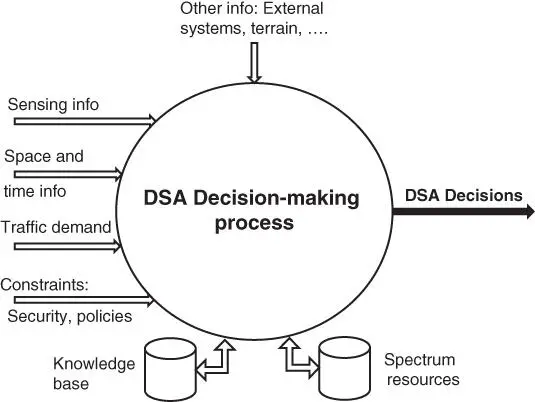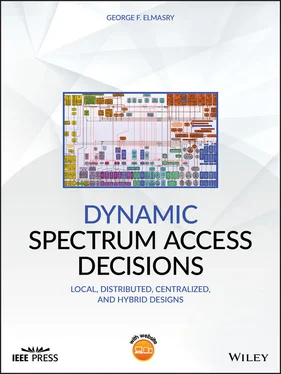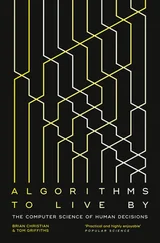1 ...7 8 9 11 12 13 ...52 
Figure 1.3Conceptual view of DSA decision‐making process timing.
It is important to consider this hierarchy of decision making when designing a hybrid DSA system. Local DSA decisions have to be quick, distributed DSA decisions have to be more insightful, and centralized DSA decisions have to be long lasting in order for the design to achieve the aspects described below and avoid the pitfalls described in Section 1.5.
Taking into consideration the hierarchy of DSA decision making, a comprehensive DSA design will consider these important aspects:
1 Avoid rippling effects. Rippling effects here means that the machine‐based decision‐making processes switches a user or a network from frequency f1 to frequency f2 only to decide quickly to switch back from f2 to f1. This rippling effect can reduce the throughput efficiency of the network and diminish the optimized use of the spectrum resources pool of frequency.
2 Consider traffic demand. In a large‐scale set of heterogeneous networks, centralized DSA decisions can be more successful in allocating more frequency bands to networks where there is high traffic demand. This will increase the overall throughput of the managed networks. With DSA, spectrum is a commodity that can be distributed to overcome interference and resources should be increased where demand increases.
3 Consider secondary user rules. If the system being designed is for an opportunistic use of spectrum as a secondary user, the design has to adhere to the secondary user rules. Secondary user rules give the primary user the first right to spectrum use and spectrum sensing has to always be on the lookout for primary user activities. Secondary user rules are discussed in more details in Chapter 2.
4 Consider hidden node effects. The challenges associated with hidden nodes are discussed in the next chapter. Being able to sense spectrum use from different locations helps avoid this challenge. In a hybrid system with a centralized spectrum arbitrator and using a large set of spectrum sensors, the hidden node challenge can be mitigated effectively.
5 Consider the hierarchy of response times mentioned above. Local decisions are fast, distributed decisions are slower and more insightful, centralized decisions are intended to be long lasting. A hybrid DSA decision system design has to consider making the different DSA hierarchal levels work in harmony.
6 Avoid conflicts with other decision‐making processes. This challenge can surface as SDR and SDN allow the incremental addition of software modules that can be prone to making contradicting decisions. Consider this example: a software module makes adaptive power control decisions. This module can obtain SNIR information from the physical layer and decides to increase power to overcome low SNIR assuming that the peer node, from which it received a signal with a low SNIR, is suffering from the same degradation reciprocally. In the meantime, a DSA agent obtaining the same SNIR metric attempts to switch frequency to overcome the low SNIR. There are pros and cons for each of these decisions. Increasing spectrum emission power can quickly fix the low SNIR challenge but may reduce frequency reusability in a large‐scale set of networks. Switching to a new frequency can also address the low SNIR challenge radically but can be a greedy decision. The new frequency may have been more needed by a neighboring network. The main point here is for the designer to consider how SDN and SDR can have other software modules that address spectrum conflicts from different angles and make sure DSA decisions are made in harmony between all spectrum access techniques. Chapter 5 explains the value of using a generic cognitive engine skeleton at all entities of DSA decision making with a single information repository and a single decision maker. This skeleton design ensures that a single process makes all the DSA‐related decisions (i.e., offers all DSA services) at any given DSA service entity.
Clearly, DSA decisions are not “one size fits all”. Depending on so many factors and other design decisions, one has to articulately consider all the design aspects of DSA. A comprehensive DSA system may have a mix of local, distributed, and centralized decision making and a good design must consider the order of time 5these decisions ought to take, which decision to make at which area, and how to coordinate between all DSA‐related decision‐making capabilities.
1.3 The Impact of DSA Control Traffic
As the old saying goes “there is no free lunch”. With DSA, the amount of control traffic could increase. In order to create distributed and centralized aspects of DSA, spectrum sensing information has to flow from sensor nodes to other sensor nodes or to the centralized arbitrator. Negotiation between distributed agents could use control plane bandwidth as well. Configuring sensing nodes on what frequency bands to sense will also require messaging over the air. The tradeoff between the increase in control traffic and the gain obtained from DSA optimizing the available spectrum resources must be quantified. In a network that operates on a narrowband of frequency, which results in a low bit per second transmission rate, the amount of control traffic increase may render the gain from DSA techniques worthless to this network. In a heterogeneous set of networks, such a low bandwidth network may be allocated a fixed frequency and the global DSA design may have to work around this fixed frequency assignment when optimizing spectrum resources for the rest of the heterogeneous networks.
Even when we are certain that DSA gain exceeds the impact of DSA control traffic, DSA design has to find ways to reduce the impact of DSA control traffic through techniques that do some local processing (fusion) of spectrum sensing information and abstract them before sending them OTA such that we do not compromise spectrum sensing information relevance while we minimize the use of OTA resources for DSA control traffic.
1.4 The Involvedness of DSA Decision Making
Figure 1.4shows how the DSA decision‐making process has to consider many factors. Notice that Figure 1.4does not attempt to put the DSA decision‐making process in the context of a cognitive engine, which can be in a cognitive radio or a cognitive network node. Rather, the figure shows the place of the DSA decision‐making process independent of how it is implemented and without reference to implementation.

Figure 1.4The involvedness of the DSA decision‐making process.
As Figure 1.4shows, in addition to spectrum sensing information, the DSA decision‐making process involves the following:
1 1‐ Spatial and time information. Geolocation information is critical to most DSA decision‐making processes. Cooperative distributed agents have to pass geolocation information to each other for spatial reference. As for time, sensing information has to have time reference so that the DSA decision‐making agent can utilize the most relevant measurements and estimate tendencies.
2 2‐ Traffic demand. As mentioned above, the DSA decision‐making process should be fair in terms of considering traffic demand. More spectrum resources can be dynamically allocated where there is more traffic demand.
3 3‐ Constraints. These include security constraints, rules, and policies. It is critical for the DSA decision‐making process to adhere to security constraints. For example, encryption of geolocation information can be a security constraint. Secondary user rules are one example of DSA rules. Chapter 5 is dedicated to DSA as a set of cloud services that relies on policies, rule sets, and configuration parameters to constrain the DSA cognitive engine evolver. DSA has to evolve within the intended use of the managed networks. In military communications, it is critical to reflect the commander's intent in the DSA policies, rule sets, and configuration parameters in order to meet the mission needs.
Читать дальше














